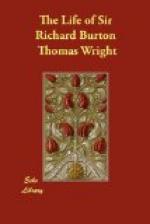In reply, Mr. Payne sent him some twenty or thirty names in half a dozen literatures. From Geneva the Burtons made their way first to Vevey, where Sir Richard revelled in its associations with Ludlow, the English regicide, and Rousseau; and then to Lausanne for the sake of his great hero, Edward Gibbon; and on 12th March (1889) they were back again at Trieste.
Writing to Mr. A. G. Ellis on May 8th, Burton enquires respecting some engravings in the Museum brought over from Italy by the Duke of Cumberland, and he finished humorously with, “What news of Mr. Blumhardt? And your fellow-sufferer from leather emanations, the Sanskiritist?"[FN#604]—an allusion to the Oriental Room, under which, in those days, was the book-binding department.
163. Mr. Letchford, August and September 1889.
In July, for Burton found it impossible to content himself long in any place, the Burtons made another journey, this time through Western Austria, being accompanied as usual by Dr. Baker and Lisa. After their return, on September 13th, it was necessary for Burton to undergo two operations; and Lady Burton, racked with anxiety and fearing the worst, seemed, when all was successfully over, to have recovered from a horrible nightmare. Then followed acquaintance with the gifted young artist, Mr. Albert Letchford, and his beautiful and winning sister, Daisy. Mr. Letchford became the Burtons’ Court Painter, as it were—frequently working in their house—and both he and his sister admired—nay, worshipped Sir Richard down to the ground. Even as a child, Albert Letchford was remarkable for his thoughtful look, and his strong sense of beauty. In church one day he begged his mother to let him run home and get his little sword, as there was such an ugly woman there and he wished to cut her head off. As a youth he drew and studied from morning to night, living in a world of his own creation—a world of books and pictures. His letters were those of a poet and an artist. Beauty of the mind, however, attracted him even more than beauty of the body. Thus, he fell in love with his cousin Augusta, “though she had the toothache, and her head tied up in a handkerchief.” At seventeen he studied art in Venice. From Venice he went to Florence, where he met the Burtons and got from them introductions to all the best people, including the Countess Orford and Mlle. de la Ramee (Ouida). We then find him in Paris, in London, in Egypt, where he acquired that knowledge of the East which helped him later when he illustrated The Arabian Nights. Finally he settled at Trieste. “That wonderful man, Sir Richard Burton, with the eyes of a tiger and the voice of an angel,” writes Miss Letchford, “loved my brother, for he found something more in him than in others—he found a mind that could understand his own, and he often said that Mr. Albert Letchford was about the only man that he was pleased to see—the only one who never jarred on his nerves. To him did Sir Richard, proud and arrogant to most people, open his soul, and from his lips would come forth such enchanting conversation—such a wonderful flow of words and so marvellous in sound that often I have closed my eyes and listened to him, fancying, thus—that some wonderful learned angel had descended from Heaven unto Earth.”




